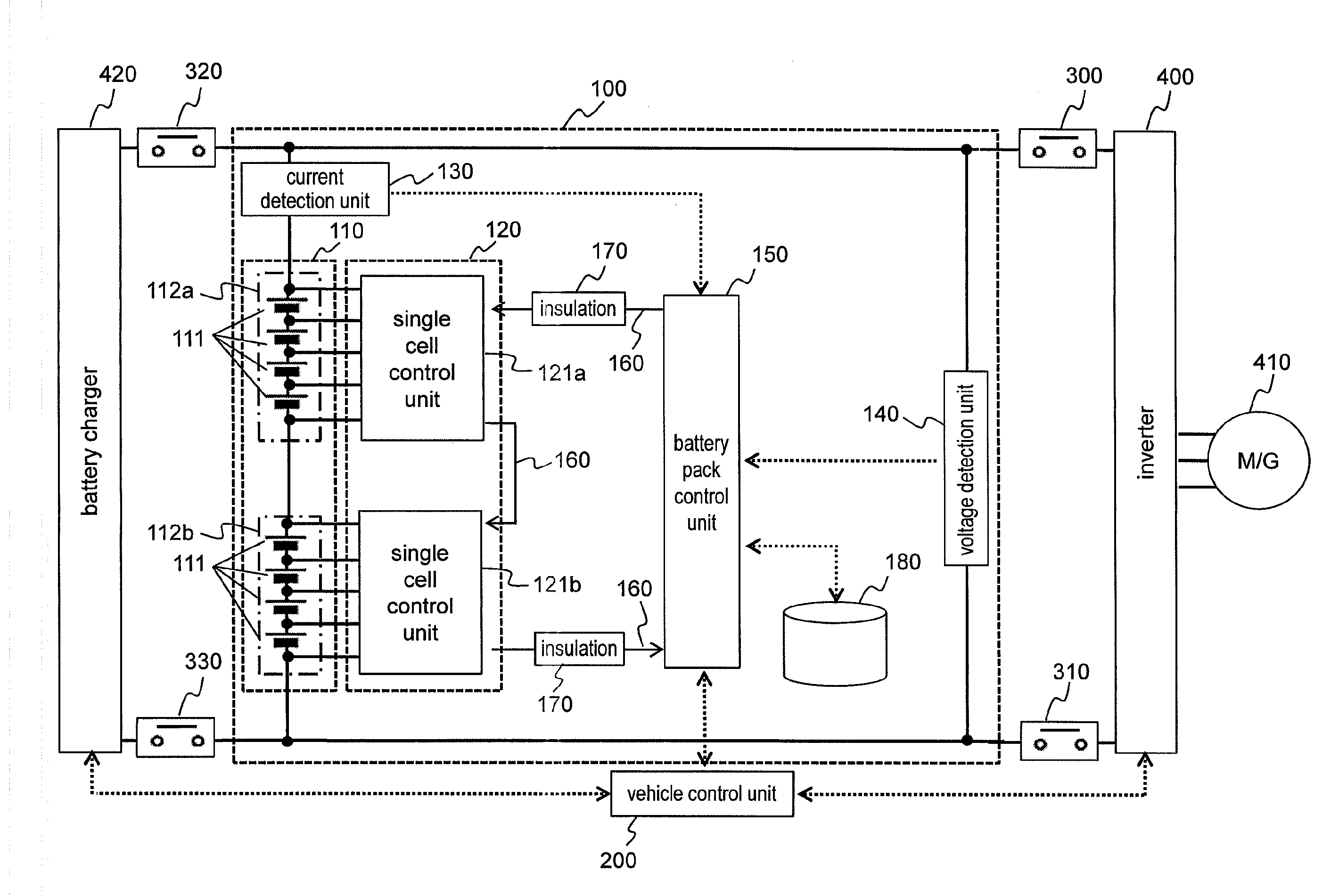Battery control device and battery system
a battery control device and battery technology, applied in battery/fuel cell control arrangement, instrumentation, capacitor propulsion, etc., can solve problems such as overcharge or overdischarge, and achieve accurate charging or discharging power.
- Summary
- Abstract
- Description
- Claims
- Application Information
AI Technical Summary
Benefits of technology
Problems solved by technology
Method used
Image
Examples
first embodiment
Conclusion
[0072]As described above, the battery system 100 of the first embodiment includes the internal resistance table 182 composed of two-dimensional maps which are provided per charging duration time and which describe the internal resistance values corresponding to the temperature and SOC of the single cells 111. The battery system 100 obtains the internal resistance value of the single cells 111 from the internal resistance table 182 by using the temperature, SOC, and charging duration times of the single cells 111. Based on the internal resistance value thus obtained, the battery system 100 acquires the permissible charging current for the single cells 111. In this manner, the optimal permissible charging current is obtained in accordance with the internal resistance value of the single cells 111 varying with the charging duration time, whereby charging control is implemented.
[0073]For the first embodiment, the operations for charging the single cells 111 were explained abov...
second embodiment
[0074]The first embodiment was explained using examples in which the internal resistance value of the single cells 111 is changed depending on the charging or discharging duration time when the permissible charging or discharging current is to be obtained. Although this method is effective for such forms of operation as electric vehicles that take a relatively long time to charge and discharge, the method may not be mandatory for forms of operation such as hybrid electric vehicles that use batteries over relatively short periods of time.
[0075]The second embodiment is explained below with an example where the battery system 100 operates switchably either in an operation mode in which the system 100 supplies power to an electric vehicle or in an operation mode in which the system 100 feeds power to a hybrid electric vehicle and where the procedure for calculating the permissible charging or discharging current is switched according to operation mode switchover. Since the configuration...
third embodiment
[0082]With the first and the second embodiments above, the permissible charging or discharging current may be calculated by taking the state of health (SOH) of the single cells 111 into consideration. The SOH in this context signifies the rate of increase in internal resistance due to deterioration. The value of the SOH is assumed to be 1 when the single cells 111 are brand-new and become larger as deterioration advances. Explained for the third embodiment of this invention is an operation example in which the SOH is taken into account. Any known method may be used to acquire the SOH of the single cells 111, and thus the method will not be discussed further in conjunction with the third embodiment. It should be noted, however, that the SOH is assumed here to be derived from the rate of increase in internal resistance detected per single cell 111 and applied to calculating the permissible current for each single cell 111.
[0083]FIG. 9 is a chart showing in control blocks the method wh...
PUM
 Login to View More
Login to View More Abstract
Description
Claims
Application Information
 Login to View More
Login to View More - R&D
- Intellectual Property
- Life Sciences
- Materials
- Tech Scout
- Unparalleled Data Quality
- Higher Quality Content
- 60% Fewer Hallucinations
Browse by: Latest US Patents, China's latest patents, Technical Efficacy Thesaurus, Application Domain, Technology Topic, Popular Technical Reports.
© 2025 PatSnap. All rights reserved.Legal|Privacy policy|Modern Slavery Act Transparency Statement|Sitemap|About US| Contact US: help@patsnap.com



